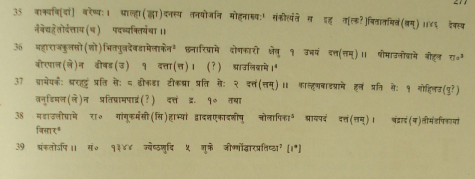| |
North
Indian Inscriptions |
| |
|
|
|
INSCRIPTIONS OF THE PARAMARAS OF CHANDRAVATI
GIRVAḌ STONE INSCRIPTION OF THE OF PRATĀPASIṀHA
 _______________________________________________________________
_______________________________________________________________
[1] Before this word is engraved another name Sathiradēvaḥ, probably for Sārthadēvaḥ, which was later on erased.
[2] The preceding word is perhaps to be read as देवडा and the word dōṇakārī has already explained by Sastri as a combination of drōṇa and khārī, both in the sense of measure. The whole of the remaining portion is in the local dialect.
[3] It is a contraction of either Rājputra or Rāüla. The reading of the name of the village that precedes is certain but it is not known whether the first letter is a part of it or to be taken as Śrī, an honorific prefix. Both ḍhivaḍā and ḍhīkaḍā (or ḍhimaḍā) are local words denoting a well.
[4] This daṇḍa is superfluous. Arahaṭṭa (or araghaṭṭa) is often, as taken here by Sastri to be a ‘Persian wheel,’ but I find nothing like Persian in it. It only means, literally, the pots attached to aras, i.e., spokes or radius of a wheel (to lift water), as we find used in Rajasthān (for irrigation) even to-day.
[5] This word too has not been explained before and some misunderstanding about its meaning still prevails, for which see P.B.P., p. 234, where is has been taken as a tax on chōllikās brought from outside the town. I take it as a combination of two words, viz. cha (and) ulāpikā which is formed from ulapa (grass). Bundles of grass for cattle-fodder are brought from the jungles even to-day. D.C. Ganguly read the word as Cōpalikā (H.P.D., p. 324) but did not explain it.
[6] This word means spreading out (articles for sale) before maṇḍapikē, i.e., a market pavilion where they were taxed.
[7] The reading of this line, which is imbedded in the portion of the wall below, has been adopted from the text in Ind. Ant., Vol. XIV, p. 79.
|
\D7
![]()
|








